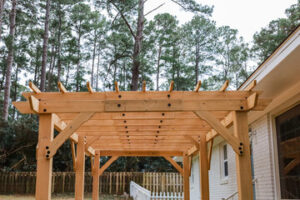A deck must be sturdy to support the weight of patio furniture, grills and friends who gather for drinks. It must also meet setback requirements and be safe to use. Check with your local municipality to learn what these standards are and to see if you need a building permit for your raised deck.

The beams that support joists and the deck surface are a vital part of any deck construction project. They provide a solid foundation that ensures the deck will hold up to heavy loads and stay stable. When properly sized and spaced, they prevent overloading that can lead to structural instability. In addition to ensuring that your deck can handle its intended load, proper beam sizing and spacing also contribute to its appearance and longevity. Contact Deck Builders Franklin TN for professional help.
The joists, which run parallel to each other, are another important component of a deck. They create internal support, providing a platform for your furniture and other deck features. In terms of size, joists vary from small to large, and standards for their spacing have changed over time. Most current deck building codes recommend a maximum of 16 in. on-center spacing.
Beams are critical to a structure’s stability and can be constructed from a wide range of materials. Regardless of their material, they must be treated to protect them from moisture and rot. Ideally, wood beams should be treated with an AWPA M4 lumber treatment, which offers the highest concentration of water-resistant compounds. In addition to treating the beams, it’s essential that you use metal connectors to attach them to the posts. Notching posts or leaving them exposed to the ground increases their risk of moisture-related decay and can reduce the lifespan of your deck.
Deck joist spans are one of the most important aspects of deck construction, and they’re often a subject of heated debate. The choice of wood species and lumber quality has a major impact on joist spans, as do the spacing between beams and joists. This is why it’s important to consult a qualified professional when choosing these components.
Joists
Deck joists are the principle framework for your deck and they distribute the weight of the deck surface, furniture, people, and other elements. The joists will also hold your choice of decking materials. Depending on the size of your deck, the joists will be spaced at 12 or 16” intervals. There are two kinds of joists: interior joists, which are spaced throughout the deck, and rim joists, which form the outer edge of your deck. Joists are attached to the ledger board with metal joist hangers or, in some designs, rested on top of the support beam.
Choosing the right joists for your project is a key step in the process of deck building. To do so, you must first calculate the load-bearing capacity of your deck. To do this, you can use a joist span calculator or consult a professional construction expert.
Once you have your joists in place, the next step is to install the ledger boards and frame of your deck. Ledger boards are what connect your deck to the house, and it’s important to attach them with structural screws rather than nails. These screws have high torque and strength, and they’ll be more secure against the joists than nails.
It’s also a good idea to install joist blocking between the joist bays of your deck. This will prevent water from permeating your joists and causing damage over time. You should use pressure-treated or rot-resistant lumber for this purpose and make sure the blocking is firmly anchored in place. You should also check with local building codes or engineering recommendations for specific joist blocking requirements.
Posts
Posts are one of the most important parts of a deck and must be properly installed to create a stable, durable structure. They transfer the load from the deck to concrete footings sunk into the ground, and they can also act as a visual design element. Choosing the right size and type of posts is crucial and may require consultation with professionals to ensure that they will meet building standards.
Post size is determined by the deck’s load requirements, which will depend on its size and location. The higher the load, the larger the posts must be to adequately support it. Local building inspection offices can provide specific guidelines for post sizes and placement.
Once the posts are in place, joists can be attached to them. These are typically comprised of two 2”x8” or 2”x10” boards joined together to create a double beam and then secured with carriage bolts.
Before installing the joists, it’s critical to plan out the layout and mark the joist spacing. This will be dictated by building codes and is usually 16 inches on-center. It’s important to leave extra space between joists for expansion and contraction of the lumber due to temperature changes, as well as for the attachment of railings and other hardware.
When installing the joists, it’s also a good idea to start at the center and work outward toward the ends of the deck. This will help keep the frame square and prevent tripping hazards. Once the joists are in place, it’s time to install the decking. Make sure the boards are level and properly fastened to the joists using appropriate decking screws or nails. If the boards are not securely fastened, they will quickly become a tripping hazard and cause injuries.
Piers
Piers are a key part of deck foundations, providing support and stability. They are used to lift and stabilize sinking or settling foundations, as well as support for walkways, decks, and solar panel arrays. When properly installed, piers are durable and long-lasting. However, they must be inspected regularly to ensure that they remain in good condition. If you notice nail pops or other signs of movement, contact a professional right away.
There are several different types of piers, each designed to meet specific project requirements. Engineers consider site conditions and anticipated loads when choosing the type of pier to use. They are typically constructed from reinforced concrete, which provides superior compressive strength and tolerance for tensile stress.
The design and construction of piers is a complex process that requires skilled contractors to achieve optimal results. They must be constructed to withstand the weight of the superstructure and live loads, as well as environmental factors such as soil erosion and seismic activity. They must also be able to accommodate changes in groundwater levels and other environmental influences.
One of the most common types of piers is the push pier. This type of pier is pushed or screwed into the ground beneath the foundation to lift and stabilize it. This type of pier is effective in a wide variety of soil conditions, including clay, sand, silt, and areas with high water tables. It can also be installed quickly, resulting in minimal disruption to the surrounding landscape.
Another option is the helical pier. This type of pier is screwed into the ground using a diesel-powered machine, making it an efficient and cost-effective alternative to traditional poured concrete footers. This method can be used in a variety of soil conditions, and it can even be installed where there are limited accessibility or headroom.
Building Permit
Building a deck is one of the simplest construction enterprises that you can undertake on your property. But before you start construction, it is important that you petition the Department of Buildings for a permit. This will ensure that you adhere to government regulations and meet standard building codes for deck construction. It will also help you avoid getting into legal trouble with the city’s authorities.
In order to apply for a building permit, you must provide a plan drawn to at least 1/4” scale that shows the deck size and height, framing members, beams, joists, and the connection to the house. You should also include a diagram of the layout and the location of the deck in relation to zoning regulations. In addition, you must submit a site plan that shows the deck in relation to any inland wetlands or watercourses nearby.
Some aspects of your deck and porch project may be exempt from the requirement for a work permit, provided that they do not exceed certain limits. For instance, some earthwork and foundation work, framing, and electrical wiring can only be performed by contractors with specialized licenses. These licensed contractors must file the necessary application with the Department and be issued a permit.
The Department will perform required inspections at various stages of construction, including foundation and footing, pier and post, deck framing, stairways and railings, and the final inspection. The list of required inspections will be provided on issuance of the permit. You should also post the building permit at the job site. Failure to do so could result in a fine or even a complete demolition of the deck. This is not something that you want to be responsible for.



